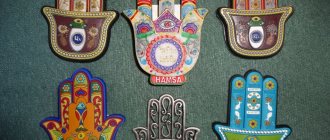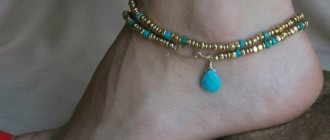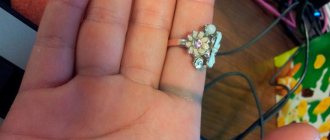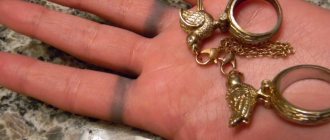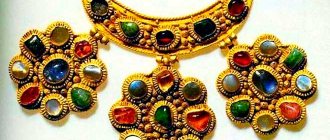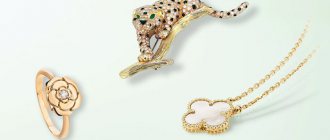Lenta.ru continues a series of publications about the history of different types of clothing and accessories. In the previous materials of the series we talked about heels, a miniskirt, a men's dress, a suit, a tie, tights and a down jacket. A new article is about the history of the bracelet, which turned from armor into jewelry.
Neanderthal amulets found in Croatia
Archaeologists are always busy with work. Because people lived in different parts of the planet and constantly traveled, remnants of their cultural heritage can be found in the most unexpected places. Still, it makes more sense to explore places where large numbers of people are believed to have lived. This is what archaeologists from Croatia did when they found ancient burials in the immediate vicinity of Zagreb.
Among various household items, eagle claws were found, covered with numerous scratches. After conducting a study, scientists came to the conclusion that once upon a time these claws served as part of the jewelry worn by Neanderthals. Presumably the necklaces were hung with them.
This discovery changed the understanding of the culture of ancient people. If earlier researchers were sure that the level of Neanderthal culture was limited only to cave paintings, now it becomes obvious that they had developed symbolic thinking. Probably, eagle claws were considered something like amulets or talismans.
The exact age of the find is difficult to determine, but archaeologists have given an approximate figure of 135,000 years. This is officially the oldest piece of jewelry ever discovered by man.
Body painting
Among the methods of decoration was painting the bodies in different colors. This was often done during ceremonies and rituals. We see echoes of this today among the aborigines of Australia and the inhabitants of the Pacific Islands, for example in Papua New Guinea. Face and body painting still accompanies ceremonies there. Australian Aborigines paint themselves with colorful clay, applying different patterns on their faces and bodies. It is interesting that, for example, lining the eyes black, coloring the lips, i.e. all the elements that we now consider makeup and use in decorative cosmetics had no decorative meaning, but were a way of scaring away evil spirits and protection.
These Australian Aboriginal children painted their bodies with clay. They used designs that date back thousands of years.
Sea beads
The second oldest trinket was found in the Skhul cave, located in Israel. There, archaeologists found beads made from sea snail shells, which were supposedly woven into bracelets and necklaces. The find is estimated to be 110,000 years old and is the first known instance of primitive people processing materials to make jewelry. If we compare these beads with the same falcon claws, then the claws were simply hung on a rope in their original form, while sea snail shells were processed by hand to obtain something like beads.
Similar bead work was discovered somewhat later in Morocco (Africa). True, she turned out to be much younger - archaeologists estimated her age at 80,000 years.
What to wear with vintage
If you come across real vintage jewelry, you will immediately feel the aura of antiquity surrounding it. Believe me, you will instantly feel its appropriateness for a particular look - it magically turns on a sophisticated sense of style.
And in general, you don’t have to worry too much about this: the now incredibly popular boho in various forms is friendly to the most incredible alliances. Moreover, there can be a lot of decorations, and absolutely diverse.
Vintage recycling is also trending – introducing modern trends into the appearance of jewelry with history. For example, your mother’s pendant with enamel can be paired with a modern weaving chain, original pendants can be added to vintage earrings, and an antique signet can be worn together with an ultra-trend ring made of baroque pearls. Antique jewelry is very expensive and few can afford it. But who’s stopping you from meticulously inspecting your grandmother’s box, wandering through flea markets, or simply purchasing high-quality modern jewelry in a vintage style?
09.01.22
Kenyan beads
For a very long time, beads from the Early Paleolithic era, found in the Enkapune Ya Muto cave in Kenya, were considered the oldest jewelry in the world. Their age was estimated at 40,000 years, and because scientists could not find anything older, they jumped to conclusions about the slow cultural development of the first people. Researchers believed that in earlier times, tribes were not particularly concerned with symbolism and appearance, since there were more pressing tasks: obtaining food, finding shelter, war for territory. But everything changed when jewelry was unearthed in Israel and Croatia.
As for the Kenyan beads, they were made from ostrich eggshells. It is surprising how carefully the ancient people processed such fragile material. It was probably at this time that humanity experienced a sharp surge in imagination and abstract thinking.
History of jewelry.
The history of jewelry goes back many millennia. Putting on chains, earrings, rings, bracelets every day, have you ever wondered how and why all this appeared? Try to answer the question: “What did people wear first—clothes or jewelry?” Correct answer: decorations.
Ancient people “clung” to themselves various objects that they found while searching for stones for tools. Of course, not just any pebbles and twigs were suitable for decoration: only rare and beautiful, from the point of view of primitive man, specimens were selected. Our ancestors considered all surrounding objects to be alive, and those that were distinguished by special perfection were higher beings endowed with magical powers. This belief gave jewelry the status of amulets. Talismans made from animal horns, teeth and bones were supposed to bring good luck and happiness. And the more difficult it was to catch and kill the beast, the more valuable the amulet made from its remains was. Jewelry made from more accessible materials: shells, fruit seeds, flowers, was worn not only on the arms and neck, but also on the legs and waist. Some were permanent, others were intended for rituals and holidays. The most ancient, of those found by archaeologists, are 100-135 thousand years old.
Our ancestors treated objects with respect and did not allow themselves to put on jewelry just like that, without thinking through its meaning and significance. In primitive society, they were amulets, talismans; from them, like a passport, one could “read” about the owner’s age, occupation and position in the clan hierarchy. Decoration acquired its purely decorative function much later. And men were the first to decorate themselves, not women, as one might think.
Earrings are probably the most popular jewelry of all times. Primitive “mods” inserted wooden sticks, shells, carved plates and even pebbles, sometimes quite large, into pierced earlobes. The Egyptians began wearing earrings in the 4th millennium BC. e., and they were predominantly female decoration. Among the ancient Greeks, Romans, Babylonians, as well as among the Arabs, Persians, and Indians, wearing two earrings was a sign of wealth, and those who stood at the lowest social level - slaves, concubines, gypsies - wore one. In Eastern Europe, earrings appeared around the 3rd-2nd millennium BC. e. In the countries of Central Asia and Transcaucasia, the tradition of putting on earrings for girls, which have been considered a talisman since ancient times, has been preserved to this day, immediately after birth. In different countries, earrings differed quite greatly in shape, symbolism and ornaments. However, almost all ancient peoples have jewelry with elements in the form of flowers, fruits, birds, animals and insects.
The ring is a symbol of immortality and infinity, power and love, and has been an attribute of marriage since ancient times. The first rings were made of thick wire and worn on the fingers and toes; later the custom arose of tying rings to the hands. In primitive society and up to the Middle Ages, a ring primarily indicated membership in a particular family and the degree of power of its owner, served as a mark and only lastly was a decoration. In Ancient Egypt, rings were worn to emphasize status. Every day after the morning toilet, a man, getting ready to leave the house, put bracelets on his wrists, a ring on his finger, and a necklace on his neck. A pendant made of jasper or carnelian on a long cord gave his appearance a special respectability. In this outfit, the Egyptian conducted business negotiations and appeared in public places. In Ancient Greece, members of the nobility wore rings as a sign of high class status. In ancient Rome, special permissions were issued to wear rings. Thus, Emperor Septimius Severus in 197 AD. allowed warriors to wear rings: they helped archers pull the bowstring, and massive rings with stone inserts enhanced the blow in hand-to-hand combat. The exchange of rings between the bride and groom, which sealed the oath of eternal fidelity, had the meaning of legal confirmation of the marriage.
The bracelet carries the same symbolism as the ring. Initially, the bracelet was a purely masculine item. During the Neolithic period, men tied a strip of leather over their wrist, thus the hand could withstand a greater load when throwing a spear, and this avoided a number of injuries. The bracelet was also used by ancient people as a talisman. It was made from animal bones and teeth, wood, rope, stone, etc. Primitive people endowed the bracelet with mystical properties and used it in rituals, using it to ward off evil spirits.
With the development of metallurgy, jewelry appeared from copper, then from bronze, and among the upper classes from gold and silver. Kings and priests could wear one or several narrow and wide bracelets on the wrist and forearm, and the Egyptians also decorated their ankles. Warriors' personalized bracelets were symbols of courage, honor and bravery. In the East, jingling bracelets have long been an indispensable attribute of dances. In Ancient Rus', bracelets were called “arms” and “hoops”; they were decorated with precious stones and pearls, gold chains were inserted into them, and the clasps were decorated with enamels. The pattern and color of the bracelet, as a rule, was combined with the entire ensemble of clothing and emphasized the owner’s affiliation with power.
The oldest necklaces found are more than 100 thousand years old and were once the shells of sea mollusks strung on a cord. The first of the neck decorations were pendants and pendants; they were made from animal teeth or stones and worn as amulets, endowed with magical properties. And the more amulets there were, the more protected their primitive owner felt, the more happiness and good luck he “shone.” This is how beads and necklaces appeared. As soon as people learned to process metal (about 8 thousand years ago), bronze jewelry appeared in the form of hoops made of a thick wire rope without a clasp, with ends close together or overlapping each other. They were worn in different countries either by women or men, or both. By this time, different types of neck decorations had already acquired a certain meaning, and their role was fully formed. Among the ancient Egyptians, neck decorations were designed to protect the heart, which was considered an extremely important organ. Their very shape - a circle - was personified with the solar disk of the god Ra. Wide chest decorations, called “pectoral” (from Latin pectus - chest) with images of events from the life of Isis, Horus and Osiris, were worn only by pharaohs and members of royal families. The value of jewelry has always been determined by its rarity and difficulty of production. It wasn't just the Egyptians who had pectorals. In 1971, a gold pectoral from the 4th century BC was found in Ukraine. e., which belonged to the Scythian king. The uniqueness of this find is not only in its antiquity, but also in the amazing skill with which it was made: on its semicircular crescent-shaped surface, figures of animals and people in different poses form a wonderful openwork pattern; they are cast from gold with incredible precision and artistic taste.
In Rus', mainly beads and necklaces (from the common Slavic gerlo meaning “throat”) became widespread, which were made from enamels arranged in complex patterns and set in gold, decorated with precious stones in high crowns and pearls. Before the birth of a child, the family council decided what jewelry he should wear and from what stone. When a child was born, a thread with beads or beads was put on him. As a person grew older, his jewelry became more numerous, and their number spoke about his well-being and position in society. One of the most popular materials for making neck jewelry was glass, which was valued on a par with jewelry stones, so you can often see it in the same jewelry with sapphires and emeralds. The oldest glass bead was found in the Thebes region of Egypt; it is about five and a half thousand years old. With the advent of various processing techniques, glass became extremely common and spread from Egypt to other countries. Roman glassblowers made each bead from several strands of glass of different colors, creating complex patterns, inscriptions and even portraits.
A brooch is a piece of jewelry that has changed more than others over its history. When primitive man first put on something more than a loincloth, he had the need to fasten this clothing. The thorns and thorns of plants, and then the curved sharp bones that replaced them, were the first to perform this function. The earliest known fibula brooches (from Latin fibula - “hairpin, clasp”) made of metal were found in Central Europe and date back to the Bronze Age (XXXV-XI centuries BC). They were similar in structure and appearance to modern pins and had an exclusively functional purpose. Analogues of pin-needle brooches, ending in a metal ball (often inlaid with precious stones or glass), were in use among the ancient Egyptians. In Ancient Greece and Rome, brooches became widespread, since clothing most often served as just a rectangular piece of fabric, which was folded in half and fastened on the shoulders. Women wore brooches on both their upper and “lower” clothes, while men wore them only on their upper clothes, pinning the fabric on one shoulder with them. Scandinavian and Celtic ancient brooches were distinguished by the fact that they consisted of two separate objects. A crescent- or circle-shaped bow held a needle, which was used to pierce fabric or skin.
Over time, decorations have changed. Gradually, the aesthetic function replaced the magical one. The story about the long and fascinating history of jewelry will continue in subsequent articles.
Altai bracelet
The oldest piece of jewelry found on the territory of modern Russia. Archaeologists discovered a stone bracelet next to human remains in the Altai region. Its age is estimated at 40,000 years. But what is surprising is not so much the antiquity of this accessory as the method of processing. It turned out that technology was used to make the bracelet, which was previously considered inaccessible to people of the Paleolithic era. Ancient people managed to smooth out all the irregularities and give the stone a smooth and slightly rough surface. How they were able to do this without having advanced stone processing tools is anyone's guess.
Some archaeologists even assumed that the author of these objects was our contemporary, but this idea was quickly refuted by analyzing the material.
What is considered vintage jewelry?
Let's understand the terminology. Truly ancient jewelry is kept, as expected, in museums and private collections of very, very wealthy people. The share of mere mortals is mainly vintage and antique jewelry of not too respectable age.
Vintage jewelry is considered to be jewelry made at least 20-30 years ago and bearing signs of the corresponding era. That is, a woman of elegant age may well have her own collection of interesting jewelry acquired in her youth.
If a piece of jewelry is half a century old, then it is already classified as an antique. But in the USA and Canada, the attitude towards this term is much more selective. Antiques are considered to be items made no later than the beginning of the century before last, that is, almost 200 years ago!
Antique jewelry can immerse us in the corresponding era with its inherent style: Empire, Art Deco, Art Nouveau, Baroque, Classicism and so on. These styles are successfully played by modern designers, but jewelry with history is especially valued.
Rare jewelry should be distinguished from vintage and antique jewelry. These are the rarest pieces, released in a limited edition or completely one of a kind. And it doesn’t have to be very old!
Tracing the path of costume jewelry from vintage to the present day, you can notice several trends:
- Ancient jewelry, for the most part, is of higher quality and more durable than modern jewelry (especially when it comes to industrially produced jewelry). Consider your grandmother’s gilded brooch: most likely it is perfectly preserved for such a venerable age.
- Modern materials for making jewelry are more diverse. Of course: jewelry epoxy resin, polymer clay, foamiran - these are all very young materials. And amateur craftsmen create beauty from literally everything in the world!
- Vintage jewelry is usually more intricate in design. About 50 years ago, the minimalist style was a revolutionary innovation. Most fashionistas still preferred more sophisticated jewelry: with filigree, play of enamels, interesting combinations of stones, and so on.
- In antique jewelry, imitation of jewelry is clearly visible. In those days there was no fashion for natural materials (leather, coarse threads, wood). Therefore, costume jewelry was created according to the same principle as jewelry, only even more “expensive and rich.”
Vintage jewelry is especially valued for its presentable appearance. Only noble signs of age (such as patina, scuffs, minor scratches and unevenness) are acceptable. Frankly restored jewelry is valued lower than those preserved in its original form.
Vintage jewelry from famous brands is especially appreciated. Some of them are still alive today (Chanel, Christian Dior, Fendi, Givenchy), others have sunk into oblivion and are known only to collectors.
The most expensive and well-preserved specimens are included in special catalogs and sold at auction for incredible sums. However, true connoisseurs of antiquities know that by wandering through the flea markets of European and American cities, you can become the owner of an incredible rarity for relatively little money.
Silver earrings with enamel and cubic zirconia (go to the SUNLIGHT catalogue)
Modern jewelry made “antique” should be distinguished from vintage and antique jewelry, that is, using techniques and materials popular in the corresponding era.
Provided the quality is good, vintage-style jewelry can be used to create stylish looks. They cost much less than analogues with history, so they are available to a wide range of fashionistas.
Treasures of Varna
We move to Bulgaria, or rather to the necropolis of Varna. This place has always been considered a real treasure trove of ancient jewelry dating back to 4-5 millennia BC. The burial pit alone was chock full of valuable finds. But this was no longer the crude work of Neanderthals, but the fruits of the labor of the first jewelers of antiquity, who learned to smelt precious metals. Most of the accessories from the Varna necropolis were made of gold. These include bracelets, rings, necklaces, medallions, and earrings - scientists have never seen such a massive accumulation of ancient accessories before, so the find is considered one of the most valuable for archeology.
Chanel and Simpson
After the First World War, almost all the rigid conventions of women's fashion of previous centuries became a thing of the past. Women, even wealthy ones, were able to wear not only unpretentious short skirts and trousers, but also inexpensive costume jewelry, a taste for which was instilled in them, in particular, by Chanel, who often wore large cuff bracelets with eight-pointed crosses made by the aristocratic master Duke Fulco di Verdura.
Wallis Simpson wearing a bracelet, 1936
Photo: Mary Evans/Diomedia
Economic crises led to an increase in gold prices, which is why even the fashionable jewelry house Van Cleef & Arpels offered its clients bracelets made of bakelite, ivory and ebony, very moderately inlaid with gold, enamel, mother-of-pearl and semi-precious stones.
As soon as the financial situation improved, jewelers from haute joaillerie houses resumed working with precious metals, diamonds and rare colored stones. In 1932, Chanel herself briefly changed her passion for costume jewelry and released a jewelry collection made of white gold and diamonds with motifs of comets and feathers.
The tone for jewelry fashion in the interwar period was set by the Duchess of Windsor, Wallis Simpson. The wife of the abdicated British King Edward VIII loved bracelets: they emphasized the thinness of her wrists. Wallis wore chalcedony bracelets from ahead of her time jewelry designer Suzanne Belperron.
The Duchess did a lot to popularize the Panthère de Cartier motif. The panther was also invented by a woman - the creative director of the Cartier house Jeanne Toussaint, a contemporary of Simpson. Among other creations at home, the Duchess of Windsor had a bracelet in the shape of a panther, covered with diamonds. Because Simpson was imitated by many, the wild cat jewelry became a huge hit and remains so to this day.
Egyptian glass necklace
The Egyptians made enormous contributions to world culture and religion. This civilization stood at the origins of modern society. What’s especially amazing is the success she managed to achieve, given her less than favorable location. After all, Egypt has always been surrounded by deserts.
Egyptian jewelers actively used precious stones, gold and silver in the manufacture of jewelry. But now we are not talking about them, but about a necklace made of colored glass, dating back to the 3rd millennium BC. It’s amazing how much fine work the ancient craftsmen did when casting complex figures and mini-figurines. Even modern designers would envy this, but these accessories are already more than 5,000 years old.
Rococo and parure
In Europe, bracelets entered (or returned) into aristocratic fashion around the 17th century, along with the fashion for dresses with sleeves shortened by three-quarters, or dresses that left the arms completely bare. This fashion appeared in Europe earlier than in Russia. In our country, women began to bare their arms under Peter I, who introduced Western European customs.
As a rule, such outfits were worn by rich aristocrats (and later, in the mid-19th century, representatives of the wealthy bourgeoisie) on special occasions: at balls, evening receptions, at court. The Empire style, which spread in Europe and at the Russian court at the very end of the 18th century, introduced fashion not only for short sleeves of high-waisted dresses “in the Greek style”, but also for “Greek” bracelets in the form of snakes entwined around the wrist. Such decoration, reminiscent of the legend of Queen Cleopatra, can be seen in the portrait of Grand Duchess Elena Pavlovna by Bryullov.
“Portrait of M. I. Lopukhina”, 1797
Image: Vladimir Borovikovsky
Evening fashion in the 19th and early 20th centuries included cuff cuffs or wide flexible bracelets with a clasp. They were part of the parure (a complete evening set of decorations). In addition to the bracelet, the parure included a ring, necklace, earrings and hair decoration (tiara or diadem) of the same design. For the parure, only gold (sometimes there were platinum parts), precious stones and pearls were used.
At the end of the century before last, women (by the way, earlier than men) began to wear watches on bracelets. The evening watch is just a cuff bracelet, in which the dial is most often hidden. A real breakthrough for jewelry watches was the invention in 1929 by watchmakers of the Swiss manufactory Jaeger-LeCoultre of the Caliber 101 mechanism, which weighed about a gram. From that moment on, watches in evening bracelets became almost invisible. In 1953, the British Queen Elizabeth II wore exactly this model to her wedding.
Steinja Cave in Poland and other finds from the Late Paleolithic
Excavations at Staina Cave took place between 2006 and 2010, making it a center of archaeological discoveries during that period. Many remains of Neanderthals were discovered here, as well as a large number of remains of steppe-tundra animals. In addition, archaeologists have discovered a large number of artifacts from different time periods, ranging from the late Pleistocene (2.58 million years ago) to the Paleolithic (11,700 years ago).
Subscribe to our Pulse Mail.ru, where you will find even more interesting materials.
Next to the pendant in 2010, scientists also found an awl made of horse bone. It is obvious that ancient people used bone tools to pierce objects. It is noteworthy that the awl dates from approximately the same time as the pendant. Research into the artifacts is currently ongoing. As soon as new information about them appears, we will immediately inform you about it. Finally, let me remind you that recently scientists also managed to find out what people made textiles from in the Neolithic era.

